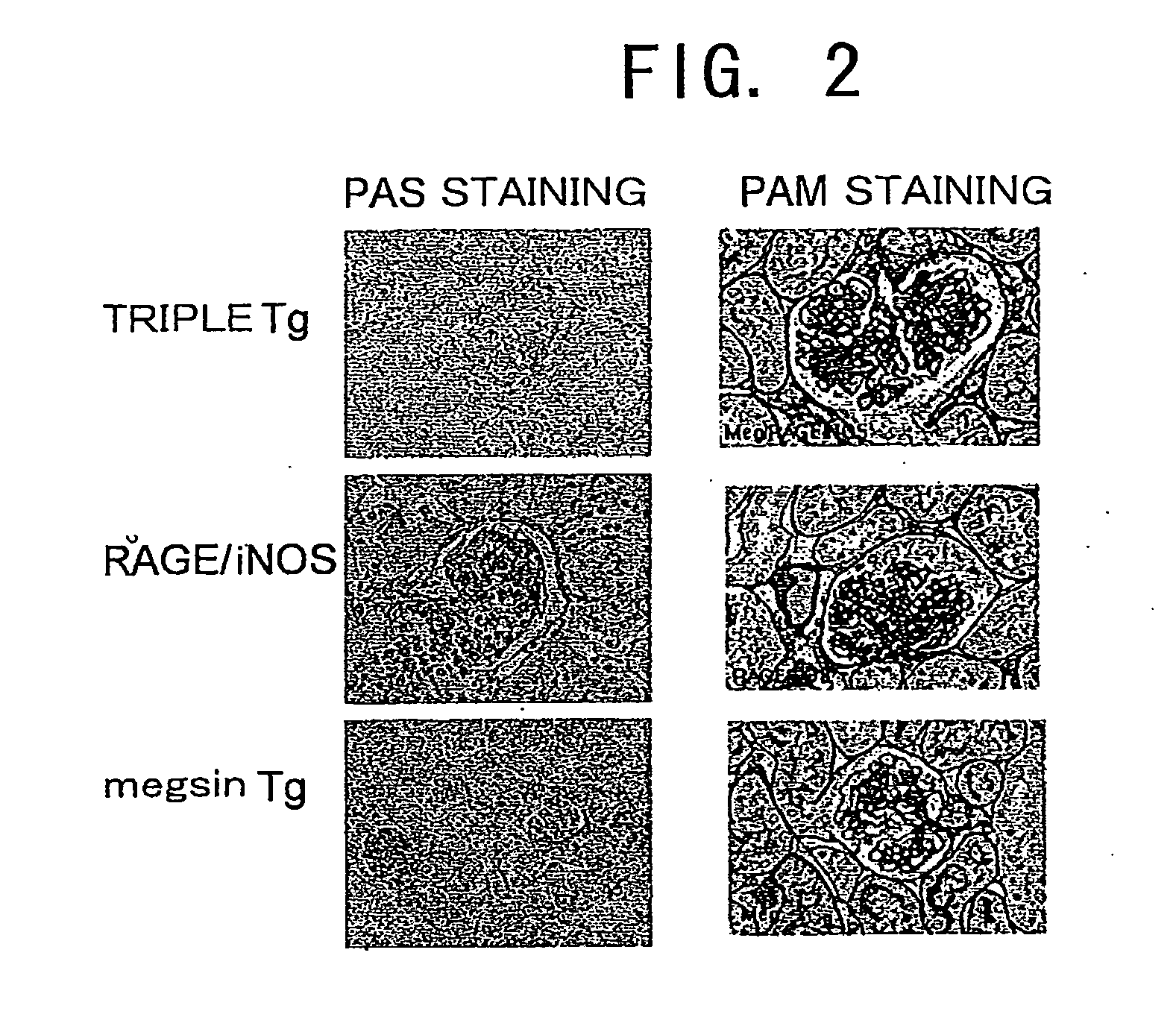Megsin/Rage/Inos-Overexpressing Renal Disease Model Animals and Methods for Evaluating Compounds Using the Model Animals
a technology of kidney disease and model animals, applied in the field of disease model animals, can solve the problems of not having all phenotypes, no known animal model that exhibits nodular glomerulosclerosis, and insufficient reproducibility and pathological findings of known animal models, so as to achieve the effect of evaluating the therapeutic effect of a test compound and the evaluation of the efficacy of the test compound as a therapeutic agen
- Summary
- Abstract
- Description
- Claims
- Application Information
AI Technical Summary
Benefits of technology
Problems solved by technology
Method used
Image
Examples
example 1
Preparation of Megsin / RAGE / iNOS-Tg
[0108]RAGE / iNOS-Tg mice (Yamamoto, Y, et al., J. Clin. Invest., 108:261-268 (2001)) were crossed with megsin-Tg mice (Miyata, T., et al., J. Clin. Invest., 109: 585-593 (2002)) to obtain megsin / RAGE / iNOS-Tg mice. Genomic DNA was extracted from a tail tissue, and the expressions of RAGE, iNOS, and megsin were confirmed by PCR according to the method described in the documents (Yamamoto, Y, et al., J. Clin. Invest., 108:261-268 (2001); Miyata, T., et al., J. Clin. Invest., 109: 585-593 (2002)). Specifically, a part of the tail of a Tg mouse was excised 4 weeks after birth or later, and the genomic DNA was extracted using a DNA extraction kit (Qiagen tissue kit; Qiagen). Using the genomic DNA as template, fragments of the introduced genes were amplified by PCR to confirm the presence of each introduced gene. For the PCR detection of megsin, β-gl-3 primer (5′-CTT CTG GCG TGT GAC CGG CG-3′ / SEQ ID NO: 4) and hM2-2 primer (5′-ATC GAA TTC TGA GAT CAT AAT CC...
example 2
Pathological Findings in megsin / RAGE / iNOS-Tg
[0109]Kidneys were excised from 16-week-old megsin / RAGE / iNOS-Tg mice, and PAS staining and PAM staining of the glomeruli were carried out according to a conventional method and the method described in WO 01 / 24628. Tissues that were fixed with Carnoy's fixative, embedded in paraffin, and sliced into 4-micron sections were used in the PAM staining. PAS staining (Periodic Acid Schiff reaction) generally stains polysaccharides red. In kidney pathology, proliferation of mesangial matrix and thickening of basement membrane can be observed by staining glycoproteins in red, which are components of the mesangial matrix and basement membrane. Meanwhile, in PAM staining (Periodic Acid-Methenamine Silver stain), components of the basement membrane and connective tissues are generally stained in black (silver impregnation). In kidney pathology, sclerosis (fibrosis) of mesangial matrix and thickening of basement membrane are stained in black.
[0110]The r...
example 3
Kidney Weight and Biochemical Tests of Urine and Blood in megsin / RAGE / iNOS-Tg
[0112]Kidney weight and biochemical parameters of urine and blood in 16-week-old megsin / RAGE / iNOS-Tg mice were measured (Table 1). Other Tg mice (iNOS-Tg, RAGE / iNOS-Tg, megsin / iNOS-Tg, megsin / RAGE-Tg, megsin-Tg, and RAGE-Tg) and wild-type mice (CD-1) were used as a control for comparison. The items to be measured are as follows: body weight (BW); kidney weight (KW); serum: total protein (TP: Biuret method); triglyceride (TG: LPL / GK / GPDH-diaphorase / formazan dye method); total cholesterol (Tcho: enzyme method); urea nitrogen (BUN: urease-ultraviolet method); creatinine (Cr: alkaline picrate method); insulin (insulin: ELISA); blood glucose level (GLU: GOD / POD method); GOT; and GPT; urine: albumin (HbAlc: latex agglutination inhibition method); total protein (TP: pyrogallol red method); urea nitrogen (BUN: urease-ultraviolet method); and creatinine (Cr: alkaline picrate assay). The results of TP, CRE, and GLU a...
PUM
| Property | Measurement | Unit |
|---|---|---|
| weight ratio | aaaaa | aaaaa |
| molecular weight | aaaaa | aaaaa |
| temperature | aaaaa | aaaaa |
Abstract
Description
Claims
Application Information
 Login to View More
Login to View More - R&D
- Intellectual Property
- Life Sciences
- Materials
- Tech Scout
- Unparalleled Data Quality
- Higher Quality Content
- 60% Fewer Hallucinations
Browse by: Latest US Patents, China's latest patents, Technical Efficacy Thesaurus, Application Domain, Technology Topic, Popular Technical Reports.
© 2025 PatSnap. All rights reserved.Legal|Privacy policy|Modern Slavery Act Transparency Statement|Sitemap|About US| Contact US: help@patsnap.com



